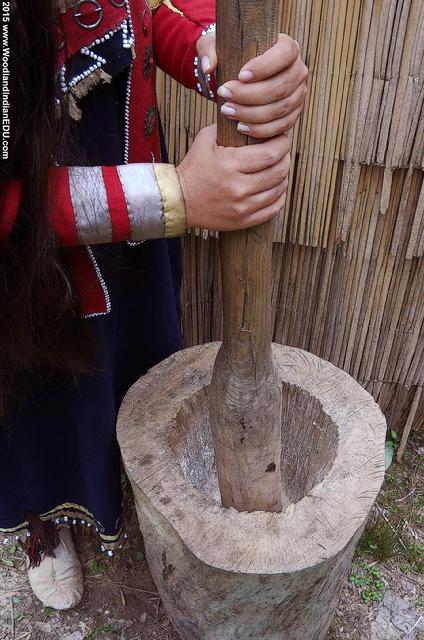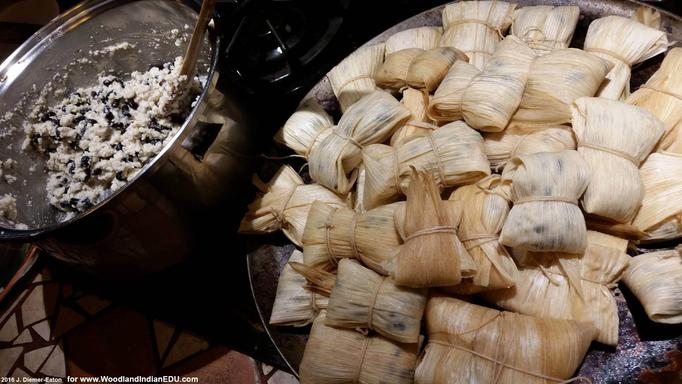Introduction to Eastern Cornbreads:
Cornbread muffins, hushpuppies, corn pone and Johnny cakes can trace their ancestry to the original cornbreads first baked, boiled and fried by the Native American Peoples. One major difference between today’s mainstream cornbreads and traditional Eastern cornbreads is the absence of leavening agents like baker’s yeast or modern baking soda. (Often I'm asked about the possible use of wild yeast... Besides a lack of evidence for its use in cornbread historically, we should keep in mind that yeast really works better with wheat gluten - the matrix that traps gas bubbles. Modern corn muffins owe their fluffy texture to the wheat gluten just as much as the leavening agents.)
------------
Native cornbreads of the past were dense, filling and very “corny” in flavor (unless cut with nut meal, squash batter, or another ingredient). Indigenous cooks were able to achieve the flavor and dough textures they wanted, whether they were making small cakes, large loaves, or dumplings... and they accomplished such without the use of now common European-introduced bread ingredients like dairy, hen eggs and wheat flour. Yet as time passed, these ingredients (particularly dairy and baking soda) found themselves integrated into traditional Native cornbreads by the late 18 to early 1900's. However some Indigenous cooks today have continued (or revived) older cornbread recipes void of Western ingredients to great success. For example, boiled corn cakes are still made for celebrations, ceremonies, and sometimes for everyday consumption (even sold) in some Haudenosaunee communities.
------------------
Two main types of corn dough were/are made: dough made of dry cornmeal, and corn batters made with the addition of hydrated corn or green corn (corn-in-the-milk cut/scraped off the cob). The first is more widely known today and serves as the base of cornbread mixes sold in boxes on supermarket shelves, while the latter is usually more known among those who bake family cornbread recipes (some recipes calling for a can of sweet corn).
---------------
Dry cornmeal was made from dried shelled corn, parched corn (roasted dry corn), or hominy/hulled corn. Dry, hard kernels were usually ground in large wooden "corn mortars” with (heavy) wooden pestles – a widespread kitchen tool found throughout the agricultural Eastern Woodlands, just like basket corn sifters. Though we might think of cornmeal as a coarse flour, much of the dry cornmeal made and used in traditional cornbreads was in fact very fine, like powder... Some recipes called for finer meal than others. Producing such a fine corn flour, enough for a family's meal, was accomplished in short time using well-designed corn mortars and pestles (something we know personally from experience).
|
 |
| The writer grinds corn in log mortar ("hominy block") with a double-headed/weighted wooden pestle, made for the job. |
|
|
Breads Made of Dry Cornmeal, and More:Because cornmeal of unprocessed corn (plain dried corn) can be gritty, many had their own methods to soften the cornmeal texture when a hearty bread was not desired. Europeans took early notice of Native cooks cooking/boiling their cornmeal... such a practice softens the gritty grains of the meal. James Adair mentions the Native practice of steeping a loaf (cornbread) before baking it. These practices of precooking meal were probably much more widespread than ever seen or recorded by outsiders. -------------------Breads made of dried hominy meal are said to keep their shape better than plain corn flour. In the alkali treatment corn starches gelatinize, creating a different texture for bread-like applications. You may recognize coarsely ground hominy meal today by the name of grits. Hominy dough could be made of either dry hominy meal or wet hominy paste. Such cakes made of hominy/hulled corn batter were, and still are, usually boiled to cook.--------------Other ways to change the dough texture, and taste, was by adding other ingredients. Nut meals and nut milk were noted to be added to bread dough; the oily nature added a pleasing texture to corn dough. Hickory nuts, butternuts, and walnuts were all used, as well as chestnuts. Chestnuts were a favorite nut among southern New England and Mid-Atlantic Native communities, being used in cornbreads and corn puddings. Acorns, while they contain tannic acid (some more than others), the higher tannin content was simply leached out to make the nuts digestible. Acorn meal could be made in large quantities, an example the Native Peoples of southern California had demonstrated quite successfully (an area where horticulture was unnecessary due to the provisions of the oaks – making acorn meal the predominant grain of this west coast region).-----------------Other ingredients historically noted to be added to dry cornmeal dough includes beans, squash, and berries... and berries are still a popular ingredient added to boiled corn cakes among Indigenous cooks around the Great Lakes. Squash and beans could be added fresh, or dried and ground into a meal that was mixed with the cornmeal. Whole beans added to cornbread was, and still is, very popular... bean breads are still boiled and served today at some gatherings in the southeast. Other ingredients like dried deer, bear and other meats were ground into a powder and mixed into the meal, adding flavor and protein. Maple sugar was sometimes added to breads among the Northern communities, while salt was used a little more often among Southern Native communities (and presumably among Mississippian folks in the midwest), until some European flavors took hold in Native cuisine and salting foods became a little more widespread. Some breads were enjoyed with a smear of bear grease or dipped into meat juices or gravies of sorts. The flavor variations were numerous, and Native cuisine took full advantage of the breadth of ingredients and combinations.
|
 |
| Photo Above: The author makes leaf/bean bread in her kitchen, combining corn dough made of hulled Iroquois White Corn (from Iroquois White Corn Project) with heritage Cherokee beans (grown by the author). The leaf bread is next cooked in boiling water. |
|
|
Green Corn Breads and the "Tamales” of the East:The second type of corn dough was made from green corn (fresh corn). In using green corn to make bread, the corn kernels were cut, or scraped from the cob. Deer jaws are prime tools for this job - the back and forth motion of the teeth saws through the kernels, popping the soft seed insides out of the hulls. The fluffy mass made of "corn-in-the-milk" (as it's often referred to), was then prepared into a moldable dough (when mixed with dry meal) or wet batters. Often this type of batter was utilized in tamale-like applications, where the batter was enclosed in green husks or other types of leaves, sometimes with another ingredient (usually beans), then boiled or baked. The Kickapoo have at least a couple of these green-corn batter leaf-bread recipes,... the Iroquois/Haudenosaunee have a couple too,... and the Delaware/Lenape have a version too. Actually, probably every Native community that grew corn in the East had a version, or two or three, of green-corn batter leaf breads, but we'll explore only a few here. -------------------------Historically, the Delaware/Lenape were noted to use green corn meal to make a tamale-like dish – that is cornbread baked in a cornhusk envelope. Nora Thompson Dean, when referring to traditional Delaware dishes she grew up with in the early 20th century, states that baked corn-in-the-milk bread was also at times dried for later use. This was achieved by baking green corn batter (the batter made by grating green cob corn on a rough wooden grater), crumbling the baked bread and then laying it out to dry (which for her meant laying it out on sheets on the roof of her home). Dried corn-in-the-milk bread or “kahahpon" was added to cold water, boiled for a while and flavored with grease... from bread to samp.-----------------------Many of these leaf breads, whether using green-corn batter or dry cornmeal, included beans and referred to as either leaf bread or bean bread (depending on the culture). The Cherokee are probably most famous for bean bread, but their Iroquoian cousins to the north, the Haudenosaunee, also have a version of bean bread too. A Kickapoo version of leaf bread included beans, and the Choctaw call their leaf/bean bread "banaha." For many Native communities, this leaf/bean bread is still made and consumed, often for special occasions. -----------------------The Haudenosaunee also made and enjoyed baked small cornbread cakes in husks, but larger loafs of green or corn-in-th-milk cornbread were also cooked in the green leaves of basswood trees. In making this bread, known as "ogon’sa," Haudenosaunee cooks poured the runny milky corn batter into leaf-lined cooking vessels (presumably earthenware pots before trade metal kettles), sealing the top with the same leafs. The pot was then surrounded by hot coals (an option for pit/ground baking) or suspended over a fire and covered with hot coals on the top... and the green corn baked overnight. By morning, the bread was done baking into a gummy bread said to be the most delicious of all cornbreads (It's one of my personal favorites!). And like the previous Delaware/Lenape recipe, this bread was also noted to be saved for later consumption - sliced and laid out to dry thoroughly. When desired, the dried slices of bread were boiled for a short time. ---------------------Indeed, whether baking cornbreads in husk/leaves, drying cornbread for later use, or enjoying a cornbread mush, many horticultural Eastern Peoples created similar dishes, probably due to a history of similar crops, lifestyles, and communication between communities/cultures. Today some communities still make wet corn-batter breads and/or leaf breads, at least for special occasions.
|
Further Reading:
- “A Woodland Feast” by Carolyn Raine
- “Acorns and Bitter Roots” by Timothy C. Messner
- “Lenape Indian Cooking” with Touching Leaves Woman (Nora Thompson Dean)
- "History, Manners, and Customs of the Indian Nations Who Once Inhabited Pennsylvania and the Neighbouring States" by John Heckewelder
- "Indian New England Before the Mayflower" by Howard S. Russell
- "Parker on the Iroquois" by Arthur C. Parker
- "The Mexican Kickapoo Indians" by Felipe and Dolores Latorre
|
Originally published (with Yahoo! Voices) in 2011, updated 2014 & 2018. To cite this article: Diemer-Eaton, Jessica. (2018, November). Traditional Native Cornbreads of the Eastern Woodlands. Retrieved from http://www.woodlandindianedu.com/cornbread.html
|
|